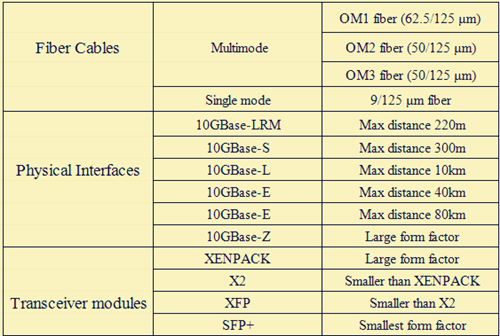As the need for high data rate increases and the supporting optical devices becomes more affordable, many network designers are inclined to upgrade their infrastructure to higher-speed network like 10 Gigabit Ethernet. Currently 10G Ethernet is ubiquitous in data center. But do we really know about 10 Gigabit Ethernet? The following passage will provide some basic information to help you smoothly migrate to 10 Gigabit Ethernet.
Fiber cable type, 10 Gigabit Ethernet physical interface and fiber optical transceiver module are the crucial components of 10GbE deployment. Table 1 demonstrates the standard fiber cables, physical interfaces, and transceiver modules that can be applicable to 10 Gigabit Ethernet.

10G SFP+ transceiver, as an essential component to support 10G network, will be introduced in the next part. SFP+ supports speeds of 10Gbps or higher over fiber. The SFP+ product family includes cages, connectors, and copper cable assemblies. It is also similar to the performance requirements of SFF-8431 and also supports 8G Fiber Channel and 10G Ethernet applications. Take 46C3447 as an example, it is 10GBASE-SR SFP+ that can support a distance of 300m over OM3 cable.
10G Ethernet Fiber Cabling
As 10G cabling standards develop over time, there are three different copper cabling technologies for 10 Gigabit Ethernet. First, 10GBase-CX4 is the first 10 Gigabit Ethernet copper standard. It’s relatively economical and allows for very low latency. But the form factor is too large for high density port counts in aggregation switches.
Second, Small Form-factor Plus (SFP+) is the latest standard for optical transceivers. 10 Gb SFP+Cu direct attach cables (DAC) directly connect into an SFP+ housing. It’s the best copper solution for servers and storage devices because it has low latency, small form factor and reasonable price.
Third, 10GBase-T is a fully IEEE compliant Ethernet transport technology standard, as defined by IEEE 802.3an-2006. 10GBase-T is to run 10 Gigabit Ethernet over CAT6a and CAT7 copper cabling up to 100 meters. 10GBase-T copper twisted-pair cabling can enable the earlier 10MB, 100MB and 1GB operation. However, 10GBase-T still needs to be improved on its price, power consumption and latency.
SFP+ Direct Attach Cables
SFP+ direct attach cables integrate SFP+ compatible connectors with a copper cable into a low-latency, energy-efficient, and low-cost solution. SFP+ direct attach cables offer the smallest 10 Gigabit form factor and a small cable diameter for higher density and optimized rack space in 10GbE uplinks and 10 Gigabit Fiber Channel SAN and NAS input/output connections. To use SFP+ direct attach cables can save you a lot compared with fiber optic solutions. And it can still provide lower latency and save up to 50% power consumption per port than other copper twisted-pair cabling systems. For example, JD097C is HP SFP+ passive copper cable that can support a link length of 3m.
SFP+ direct attach cables can also provide enhanced scalability and flexibility. The cables connect several servers or storage devices together in a single rack. Thus, it reduces the use of intermediate patch panels. And it’s easy to move racks or deploy one rack at a time since the cabling outside of the rack is limited to the main switch connection.
Conclusion
The increase in network bandwidth is driving the need to develop new products that will handle the network traffic and improve network performance. The 10GbE is presently underway to create a brighter future of fast-speed. And after years of development, there has been various different form factors and optics cable types introduced including XENPAK, X2, XFP, SFP+ and SFP+ cable. Fiberstore provides a full range of 10 Gigabit Ethernet solution, including fiber cables, copper cables, and SFP+ direct attach cables.
评论
发表评论